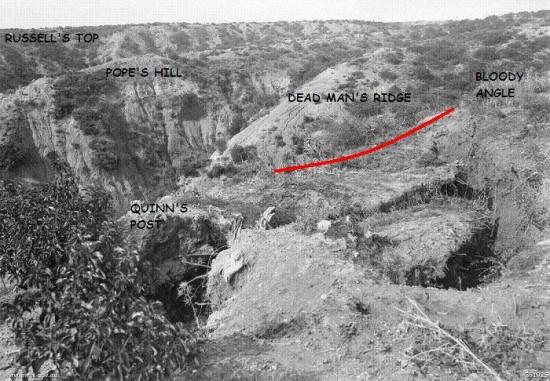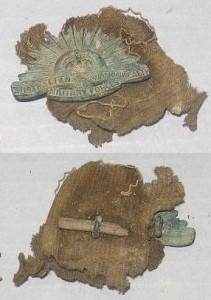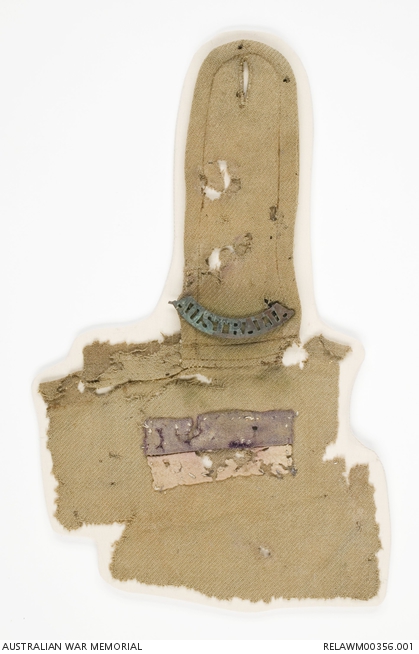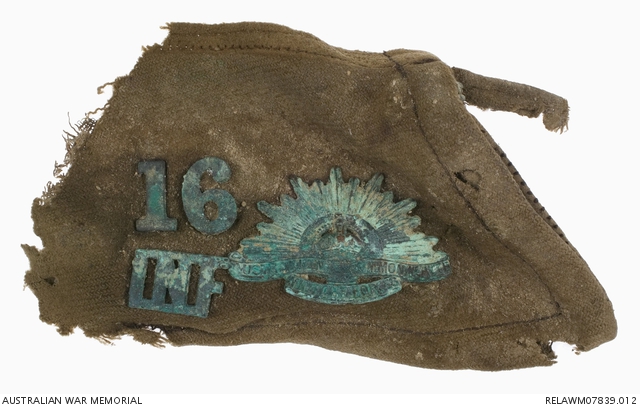Relics of the 16th Battalion at the Bloody Angle, Gallipoli, 1919
In January 1919 tattered pieces of uniform were found lying among the bones of the men of the 16th Battalion, who were killed trying to advance at the Bloody Angle on 2 May 1915. These items were recovered by Lieutenant William Hopkin James, who headed a small party to Gallipoli for the Australian War Records Section (the precursor to the Australian War Memorial). They arrived at Gallipoli in mid December 1918, and remained there until late March 1919. With the assistance of members of the 7th Light Horse Regiment, who were stationed in the area at the time, they collected items, and photographed the area. In February 1919 they were joined by the Australian Historical Mission, led by Official Historian C E W Bean.
These fragile pieces of collars and shoulder straps were found in a gully between Dead Man's Ridge and Quinn's Post, leading up to the Bloody Angle. The photograph below shows the area to the left of Quinn's Post, with the gully where the bodies of the 16th Battalion men were found indicated in red, leading up to the Bloody Angle.

These small fragments are evidence of the battalion's activities at Gallipoli, and also illustrate how men wore their uniforms. In one instance we have even been able to link an item with the man who wore it, 90 years after the item was collected!
An interesting section of collar with the Rising Sun badge shows how men 'made do' during the campaign. Normally metal badges were attached to the uniform by inserting the lugs on the back of the badge through the fabric, and then threading a split pin through the lugs. However the man who wore this badge, must have lost his split pin, and replaced it with a sliver of wood - possibly a match. It was still in place, attaching his badge to his uniform when he died in May 1915.

The change from metal unit shoulder titles to cloth unit colour patches was ordered while the battalions were training in Egypt in March 1915. However these members of 16 Battalion, were still wearing their shoulder titles in early May. It is possible they had not received their patches before the battalion left Egypt in April; or they had been allocated their patches, but retained their metal numerals out of affection for them.
Certainly other units were wearing colour patches during the early weeks at Gallipoli. The piece of uniform below, is from a member of the 6th Battalion, who fought at the Second Battle of Krithia at Helles on 8 May 1915 and shows his faded battalion colour patch. This piece was found by the Australian Historical Mission in March 1919.
Part of uniform showing 6 Battalion cloth patch from Krithia, 8 May 1915
One of the other 16 Battalion items collected at the Bloody Angle, was a second lieutenant's shoulder strap (below). Of the officers killed at the Bloody Angle, only one, Harry James Burton was a second lieutenant at the time. Burton is shown in the group photograph below, in the back row, third from the right. He was only 20 years old when he was killed at the Bloody Angle.
Second Lieutenant Harry James Burton's shoulder strap, 16 Battalion
Initially I thought this piece of collar (below) was quite unusual, as I had never seen a collar with the unit titles on it, and soldiers wore their unit titles on their shoulder straps. However I later found out that when unit titles were introduced in September 1914, officers were instructed to wear their unit titles on their collars. So this piece came from the tunic of one of the officers killed at the Bloody Angle. Unfortunately, unlike the shoulder strap, we cannot say whose uniform this belonged to, as the battalion lost several officers that day. On close inspection of the photograph above, which was taken some time between March and 25 April, only a few officers are wearing unit colour patches, the rest appear to still be wearing their unit titles on their collars.
The battalion had a very high casualty rate at the Bloody Angle. It entered the action on 2 May with 17 officer and 620 men. By the time they were withdrawn from the front line on 3 May, they had suffered eight officers and 330 men killed, wounded or missing.
The remains of the 16th Battalion men killed at the Bloody Angle in May 1915, remained there until they were buried at Quinn's Post Cemetery after the war. Most of the remains could not be identified and have no known graves, so their names are commemorated on the Lone Pine Memorial. Only a small number of the men recovered from the Bloody Angle have marked graves. They were identified from details recorded on identity discs, equipment or personal possessions that were found when their bodies were recovered.
For further reading about the 16th Battalion and the collecting at Gallipoli in 1919 see:
The Old Sixteenth: Being a record of the 16th, A.I.F., during the Great war, 1914-1918 By Captain C. Longmore 1929.
Gallipoli Mission by CEW Bean 1948 (reprinted in 1952 and 1990)
Gallipoli Revisited: In the footsteps of Charles Bean and the Australian Historical Mission, by Janda Gooding, Hardie Grant and Australian War Memorial, 2009






